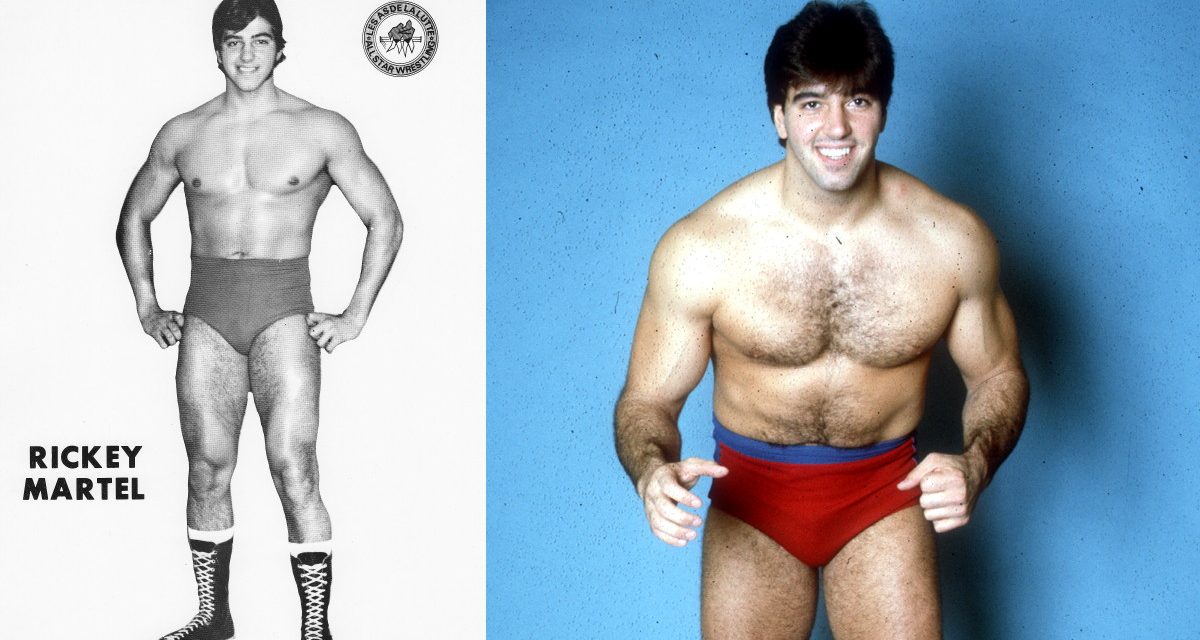For those of us who have been around that long, looking back 25 years can be like peering into a different lifetime. It’s often fun, though, to look back at school or college days, and reminisce about how, as Freddie Mercury once sang, “those were the days of our lives.”
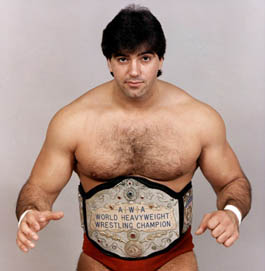
Rick Martel in a publicity pose with the AWA World title. Courtesy RickTheModelMartel.com
But for Rick Martel, looking back 25 years is to recall the greatest moment of his professional life, even including his high-profile days as the WWF’s “Model.” For it was on May 13, 1984 that he captured the AWA World Title from Jumbo Tsuruta in St. Paul, Minnesota, the only major singles title of his career.
“Wow, I can’t believe it’s been 25 years,” Martel told SLAM! Wrestling. “It was a long time ago, but it went by so fast. It’s amazing what transpired in that time. I have nothing but great memories of that day and what happened to me when I was AWA champion — my life really changed. I also got married on June 16, the following month, so it was a very exciting time in my life. Winning the title, being the World champion, and then getting married the next month — I was really on top of the world.”
But, in truth, it almost didn’t happen. Having spent the prior two years in the AWA — having previously held the WWWF Tag Team Titles on two occasions (with Tony Garea) — Martel aspired for a change, and perhaps a return to his old stomping ground. But having originally left the AWA to return to Quebec in March of 1984, when Verne Gagne made Martel aware of his plans for him, it was an offer that he could not refuse.
“I was considering going back with the WWF when the opportunity (to become AWA champion) came along. I had actually just left the AWA a couple of months prior to that, but when I was told that I could go back and win the title, I changed all my plans.
“Winning the AWA title back then was a big deal, because Hulk (Hogan) had been trying to win the title for about a year and a half before, and he didn’t succeed, so there was a lot of prestige to the title. When Nick (Bockwinkel) lost it to Jumbo, there was a lot of talk among the fans about who would take it from him. I felt really proud at the time to have been the one to do it.”
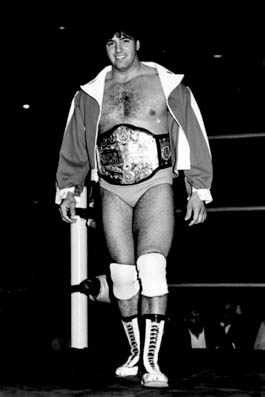
Rick Martel models the World title before a bout. Photo by Linda Boucher, The Wrestling News #113, www.wrestlingrevue.com
Speaking of Hogan, the title switch from the stereotypical foreign heel to the clean-cut babyface hearkened back to Hulk’s January 23 WWF title win over the Iron Sheik. But Martel does not believe that his title run was any sort of copy-cat angle, nor does he believe that he was being set up as a kind of Hogan equivalent.
“I don’t think Verne was trying to play off of that,” noted Martel. “I think it was more Verne trying to make a deal with the Japanese. He had big plans for Japan, and wanted to have arrangements with Jumbo and Giant Baba.
“And I certainly didn’t know what the plans were when Jumbo won the title — it was really a last-minute thing for me. When I heard that Nick had lost the title to Jumbo in Tokyo, I was surprised, and I wondered what direction they were going to go with that. So then when I got a call from Verne to fly in to Minneapolis from Quebec just to talk, I kinda knew he was going to offer me something in that area, and then when he did make the offer, I jumped at it.”
Despite the fact that Tsuruta was one of the biggest stars in Japan, and would later go on to have some of the greatest matches of the 1990s with Mitsuharu Misawa, the title switch that occurred at the St. Paul Civic Centre in St. Paul, Minnesota was a rather disjointed affair, with little in the way of traditional American wrestling, or crowd heat. Even though both were skilled technicians, Martel believes that Tsuruta’s ingrained Japanese style hampered the two from having a more memorable match.
“It was a difficult match, firstly because of the language factor, but also because of the American style. I had a lot of respect for Jumbo, but he didn’t speak a lot of English, and French is my first language, so we didn’t communicate that much in the ring.
“He was a Japanese wrestler, and he had the Japanese style. In Japan, when you wrestled Jumbo, you wrestled his style, but in America, it was easier just to wrestle to his style, too. He couldn’t quite get accustomed to the American style, so he just wrestled his way, and it felt uncomfortable.
“We were at the St. Paul Civic Centre, and I think people were wondering ‘What the hell is this?!’ because they weren’t used to the type of match we were having. We couldn’t just get going with the heat and comebacks; there was none of that, just a wrestling match. You just had to put your best moves on and hope it went well.
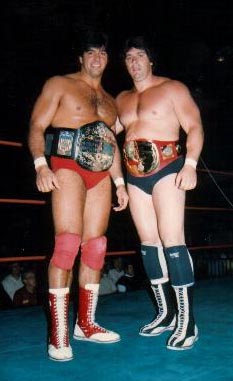
AWA World champion Rick Martel and Dino Bravo, the Canadian champion.
“I had some of the same problems with Stan Hansen. I wrestled him back before I won the title, and then also in December of 1985. I remember we had one match in Denver, Colorado, at really high altitude, and Stan was just like a bulldozer when he wrestled, he just kept coming right at you. He had been wrestling in Japan for so long, that when he came back to the States he wrestled the same way. It was like, ‘You do something to me, and I’ll do something to you,’ back and forth and back and forth. And again, the fans weren’t sure about what they were seeing. They enjoyed it, but there was no rhyme or reason for anything. So on top of being very hard matches physically, it was tough to get a reaction from the crowd.”
Over the course of his 19-month title run, Martel was presented with a number of different opponents, who wrestled various styles. There were bouts with Nick Bockwinkel, Brad Rheingans, Billy Robinson, Jimmy Garvin, and even Bob Backlund, but the one that sticks out to the former WWF and WCW competitor is the AWA vs NWA title unification bout with Ric Flair, held in Japan on October 21, 1985.
“I had some really fun matches with Jimmy Garvin — I really enjoyed wrestling him. In particular, I also enjoyed wrestling against Harley Race in St. Louis. Billy Robinson had a different style, and he didn’t care about the fans (laughs). He’d wrestle his style, his way, which was a little difficult, but that was Billy. He used to use some great moves, but in terms of making the match as exciting as you can for the fans, you could forget it. Bob Backlund was great to work with — I really enjoyed those matches. I had been in the WWF when he was the champion, and I knew him also from 1975 in Florida, when we both started. I had tremendous respect for him, both as a wrestler and a person.
“But the match that comes to mind first is against Ric Flair in Japan. That match was great, and I recently heard an interview with Ric when he mentioned it was well. It was a surprise to us, because the match was NWA vs AWA, to unite the titles, in Tokyo. What was interesting was that normally the people there just sit back and enjoy the matches, and clap at the end, but when we started the match, people got really into it, and we were very excited about it, too. I saw Ric about a year and a half ago in Houston, and the first thing we talked about was that match, which was really nice for both of us.”
There was odd situation six months prior to that encounter however, when over the course of a few weeks in June, Martel lost via pinfall to Michael Hayes in a non-title match (June 9), and then lost to him in a title match, only for the decision to be overturned (June 21). Verne Gagne, it seems, had plans on quickly pushing the former Freebird to the top.
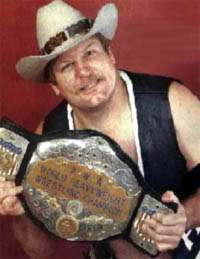
Martel’s vanquisher, Stan Hansen.
“The Freebirds were coming into the territory, and Verne really liked with Michael was doing,” Martel suggested. “It was a little controversial, but by doing that Verne was trying to show that Michael was championship material, while also trying to invigorate a certain heat between he and I. And you know, when people think that there is going to be a title change, they are more likely to want to come and see that, and I remember that after we did that match, we had a really good reaction to it.”
Martel eventually dropped the title on December 29, 1985, to the aforementioned Stan Hansen. By that stage, the title run had lasted a successful 19 months, much longer than any AWA World champion would ever hold the title again. But while one might think that the champion would be disappointed in having the belt taken from him, in this case the reaction was the opposite; having postponed moving back to Quebec at the beginning of 1984, it was now finally time to move on.
“To be honest, I was a bit relieved (to lose the title to Hansen). I had the title for 19 months, and back in those days, I had a certain freedom of going where I wanted to go, and being the World champion you were traveling a lot, and being in different places. So when I dropped the title, I wanted to go back home, which was the reason that I left the AWA before. I wanted to move back to Quebec with my wife and live there for a while. When I won the title, I had to live in Minneapolis, and after a year and a half, I wanted to be back in Quebec. I enjoyed every match, and I enjoyed being World champion, but I had done my time, and I was at peace with that.
“The whole experience was the highest point in my career, bar none” he concluded. “Being World champion was a great accomplishment, and I remember that my dream was to become a wrestler when I was a kid, and there aren’t many guys with that dream who could say they were World champions. Also, they way in which people treated me, and looked at me, after I won the title was different, and I felt that. It brought respect to me that I felt proud of. I worked hard for it, and it was great to see that hard work pay off. I was the champion and no-one can take that away from me.”
RELATED LINK
